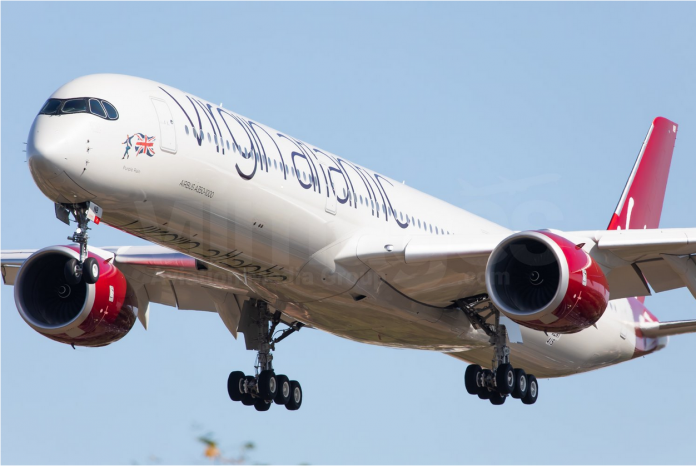Last year, I complained a lot about the massive delay in Virgin releasing their 2019 figures. It took them until January 11, 2021 to do so. They did better with their 2020 numbers, which arrived less than four months later on April 30. We still don’t have the full 2021 results, but it is good to see the headline figures being released even earlier this year.
Since we already have the 2021 results for British Airways, I thought it would be interesting to look at Virgin’s results in comparison to its arch-rival.
Let’s start with headline losses.
Headline losses before tax of £594m
The headline pre-tax loss of £594m is stated to be “before exceptional items”. They don’t say what exceptional items there were during the year, if any.
A figure for “statutory losses” of £486m is given. That is the loss after tax and exceptional items. You might expect Virgin to record a tax-credit of around 19% of the loss, based on the UK’s corporation tax rate. That would be £112m, which would quite closely explain the £108m gap between statutory losses and the headline loss figure and would suggest that any exceptional items were very small.
In 2020, Virgin didn’t book any tax credits, despite recording a pre-tax loss of £864m. That was because they couldn’t convince the auditors that there would be future taxable profits against which the losses could be offset, which would be needed to justify putting a “deferred tax asset” on the balance sheet. They don’t seem to have had the same problem this year, presumably based on their internal forecasts, with CFO Oli Byers proclaiming:
“We anticipate a return to profitability in 2023, driven by a recovery in air travel demand and more than £300m annual cost savings, already delivered.”
British Airways booked a £2,104m pre-tax loss for the same period, but that included a £131m exceptional credit. So the pre-exceptional loss before tax was £2,235m, 3.8 times Virgin’s loss. Of course, British Airways is a much bigger company. Before the crisis, BA’s revenue was 4.5 times that of Virgin’s and its capacity measured in ASKs was 3.8 times the size. So overall, I’d say that the losses incurred at both companies were pretty comparable when adjusted for the size difference.
Passenger revenue performance
You might have expected British Airways to do better than Virgin during the pandemic based on route mix. BA has exposure to domestic and European services which Virgin does not. Travel to domestic and regional destinations was quicker to recover than long-haul markets. On the other hand, leisure markets did much better than business and that would have worked the other way.
What do the figures show?
The chart below shows capacity, passenger volumes and passenger revenue results for both carriers in 2021 compared to 2019. I’ve used the company published figures for the most part, but I’ve filled in some gaps using CAA data. In particular, I’ve used the CAA figures for passenger numbers, RPKs and ASKs. Virgin said that their passenger numbers were “flat” compared to 2020, whereas the CAA data says that they were down by 7.6%. Maybe the difference is explained by frequent flyer redemptions or something? Or perhaps they were only “flattish”.

Source: Company reports, CAA, GridPoint analysis
Given the differences between the two companies’ business mix, the divergence in performance is remarkably small. Virgin was a little more aggressive in bringing back capacity, but achieved lower passenger numbers, RPKs and revenue as a percentage of 2019.
It is hard to compare the absolute figures, due to the significant differences in route mix. Virgin is a purely long-haul operator and BA operates a mix of short- and long-haul routes. That distorts unit revenue comparisons, whether on a per passenger or a per passenger mile basis.
One thing we can compare is load factor. Neither company can be particularly proud of their performance during the pandemic. One thing to note is that I’ve used the CAA data in the chart below because Virgin haven’t published a load factor figure for 2021. The CAA numbers line up pretty closely with the financial accounts, but there are some small differences, perhaps due to definitional differences such as the treatment of frequent flyer redemptions and staff travel passengers.
Part of the reason load factors are depressed is because both carriers have been operating long-haul services even where passenger demand is low in order to capture cargo traffic. Cargo yields have soared due to the lack of passenger services belly capacity. We’ll come back to cargo in a moment.

Source: CAA, GridPoint analysis
The CAA data is interesting because we can look at the monthly trends and also see how things have gone during the first couple of months of 2022. In the chart below I’ve shown the figures for passenger numbers as a percentage of 2019 for both companies.

During 2020, BA sustained more of its business than Virgin did. Part of that was due to BA’s short-haul operations, which were less restricted than long-haul early on in the pandemic. Until the end of 2020, the CAA figures allow us to split BA’s passenger numbers between European and other international routes. But even looking only at BA’s non-European passenger figures, which are much more comparable to Virgin’s business, you can see that BA still managed to outperform.
From the start of 2021, the CAA ceased to classify flights from the UK to EEA destinations as “EEA flights”. That’s because the UK was no longer part of the EEA, thanks to Brexit (don’t get me started). From that point forward, we can only compare the total passenger numbers.
In the first few months of 2021, with passenger numbers languishing at 10% or less of 2019 levels, BA cut back more aggressively, allowing Virgin to overtake it in terms of passenger recovery. But BA started picking up the pace from July onwards and opened up quite a big gap to Virgin in September and October.
Things switched around again from the start of the winter season. By November, Virgin had closed the gap and since December, they have been building passenger volumes faster than BA. That is probably due to a route mix effect. Long-haul performs relatively well in the winter months compared to short-haul, due to winter sun destinations like the Caribbean. Also significant will have been the opening up of the USA from the start of November. Whilst the USA is massively important for both companies, it’s a much bigger part of Virgin Atlantic’s business. The clue is in the name.
Cargo revenue performance
So, with not much to choose between the two carriers on the passenger side, how did they perform when it comes to Cargo?
The CAA figures allow us to track cargo volumes on a monthly basis. The following chart shows CTK (Cargo Tonne Kilometres), but we get a virtually identical picture for Cargo tonnes, which is the same metric unadjusted for distance flown.

Source: CAA, GridPoint analysis
We can see that Virgin has been kicking sand in the face of BA since the start of the pandemic. BA has never managed to carry much more than 80% of the cargo volumes it had before, whilst Virgin increased its business by almost 20% during 2021. As wide-body capacity has started to come back in 2022, both carriers have dropped back but Virgin is still doing better.
This reflects a more aggressive approach to cargo-only flights from Virgin. The next chart shows cargo volumes split by service type. Before the pandemic, neither operated much in the way of cargo-only flights. With both carriers relying on cargo capacity on passenger services, Virgin managed only 25% of BA’s cargo volumes. By 2021, Virgin had increased that to 27% of BA. But the gap in performance was even bigger when it comes to cargo carried on cargo-only services. From a standing start in 2019, Virgin managed to achieve 33% of BA’s volumes in 2021. That helped their overall cargo volumes to go from 25% of BA’s in 2019 to 30% in 2021.

Source: CAA, GridPoint analysis
Has this market share gain for Virgin come at the expense of yields? Well, no. Both companies have increased their cargo yields a lot. But there isn’t any apparent difference in the relative performance.

Source: Company reports, CAA, GridPoint analysis
So, if both carriers are performing similarly on passenger revenue and Virgin is ahead on cargo revenue, is there a difference on costs?
Non-fuel operating costs
We don’t have any detail on Virgin’s costs yet. When they publish their full accounts I might come back and dig into things in more detail. But in the meantime, we did get a figure for non-fuel operating costs of £1 billion.
To tell you the truth, I’m a bit confused by that number. It was said to be 39% down on 2019. Non-fuel operating costs in 2019 were £2.19 billion, and a 39% reduction would equate to £1.33 billion. I guess you could round that to £1 billion, but it seems a bit disingenuous.
British Airway’s equivalent figure for 2021 was £4.66 billion, a reduction of 43% on 2019. That’s better than Virgin’s reduction, but not by much.
Overall
I’m going to have to declare this contest a draw, with overall losses remarkably similar when you adjust for size.
Virgin did better on cargo, BA edged its rival on cost reduction. It’s hard to split the two on passenger revenue. BA’s numbers were slightly better, but they probably had a market mix advantage.
Which airline is better placed for the recovery is perhaps a more important question. For that, we’ll need to look in more detail at the cost position and the balance sheet.
Once Virgin publishes its full results, I’ll take a look at those questions. As the YouTubers would say, subscribe to make sure you don’t miss the next exciting instalment.






























